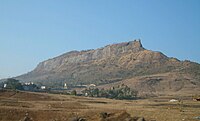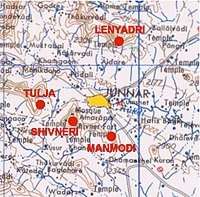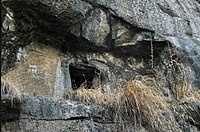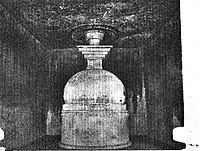Shivneri Caves: Difference between revisions
Correct capitalization |
m En dash fix (via WP:JWB) |
||
| (15 intermediate revisions by 12 users not shown) | |||
| Line 1: | Line 1: | ||
{{Short description|Ancient Buddhist caves in Maharashtra, India}} |
|||
{{for|the fort|Shivneri}} |
{{for|the fort|Shivneri}} |
||
{{Use dmy dates|date= |
{{Use dmy dates|date=February 2023}} |
||
{{Infobox Cave |
{{Infobox Cave |
||
|name = Shivneri Caves |
|name = Shivneri Caves |
||
| Line 13: | Line 14: | ||
|entrance_count = |
|entrance_count = |
||
}} |
}} |
||
The '''Shivneri Caves''' |
The '''Shivneri Caves''' are artificial caves dug for [[Buddhist]] monks circa the 1st century CE. These are now famous tourist attractions located on Shivneri Hill, about 2 km Southwest of [[Junnar]], [[India]]. Other caves around the city of Junnar are: [[Manmodi Caves]], [[Lenyadri]], and the [[Tulja Caves]]. |
||
== Description == |
== Description == |
||
The Shivneri [[Buddhism|Buddhist]] caves are located near Shivneri Fort on the top of the hill, where |
The Shivneri [[Buddhism|Buddhist]] caves are located near Shivneri Fort on the top of the hill, where Shivaji Maharaja was born. It is a group of 60 caves that were excavated in the first part of the 1st century CE.<ref name=AHIR>{{cite book|last=Ahir|first=D. C.|title=Buddhist sites and shrines in India : history, art, and architecture|year=2003|publisher=Sri Satguru Publ.|location=Delhi|isbn=8170307740|page=192|edition=1.}}</ref> At the beginning of the 2nd century CE, these caves were a flourishing center of Buddhist activities.<ref>{{cite book|last=Brancaccio|first=Pia|title=The caves at Aurangabad : Buddhist art in transformation|year=2010|publisher=Brill|location=Leiden|isbn=978-9004185258|page=27|url=https://books.google.com/books?id=m_4pXm7dD78C&pg=PA43}}</ref> The caves are essentially made of [[vihara]]s or small cells, but there are also [[chaitya]]s.<ref>{{cite book|last=Te-kʻun|first=Cheng|title=Studies in Chinese art|year=1983|publisher=Chinese University Press|location=Hong Kong|isbn=9622012795|page=212|url=https://books.google.com/books?id=7tdiC-PQdy0C&pg=PA212}}</ref> The caves are scattered on three sides of the west–east-south triangle formed by Shivneri Mountain.<ref name = "BC">Buddhist Cave Temples of India, by RS Mauchope, 1933 [https://archive.org/details/in.ernet.dli.2015.279744 {{p.|59–60}}]</ref> |
||
The caves are scattered around the hill, and categorized into several groups: the East group (1, 2 and 3), the West group, and the South group. Among the most important caves, we can mention: |
The caves are scattered around the hill, and categorized into several groups: the East group (1, 2 and 3), the West group, and the South group. Among the most important caves, we can mention: |
||
** Cave 26 |
** Cave 26 – a two-story [[Vihara]] |
||
** Cave of 45 |
** Cave of 45 – Known as "Bara-kotri", it has 12 cells for resident monks. |
||
<gallery widths="200px" heights="200px"> |
<gallery widths="200px" heights="200px"> |
||
| Line 33: | Line 34: | ||
The [[chaitya]] has on its outer face the dedicatory inscription of a merchant: |
The [[chaitya]] has on its outer face the dedicatory inscription of a merchant: |
||
{{ |
{{Blockquote|"A pious gift of charity, designed for the sanctuary, for the good and happiness of all, by Virasenaka, distinguished head of the family, confessor of [[Dharma]]"|Inscription of the great Chaitya.<ref>James Fergusson and James Burgess (1880) ''The cave temples of India'', [https://archive.org/stream/CaveTemples#page/n275/mode/2up/search/Manmodi {{p.|251}}]</ref>}} |
||
<gallery widths="200px" heights="200px"> |
<gallery widths="200px" heights="200px"> |
||
| Line 45: | Line 46: | ||
== Inscriptions by Yavanas == |
== Inscriptions by Yavanas == |
||
[[File:Menander portrait.jpg|thumb| |
[[File:Menander portrait.jpg|thumb|upright|Portrait of [[Menander I]], a [[Yavana]] king.]] |
||
Two Buddhist inscriptions made by [[Yavanas]] ([[Indo-Greeks]]) were found in Shivneri.<ref name = "Yavanas"/> They suggest the involvement of men of Greek descent with Buddhism in India, as well as the continued presence and gradual acculturation of the Greeks in India in the 1st century CE.<ref name = "Yavanas">The Greek-Indians of Western India: A Study of the Yavana and Yonaka Buddhist Cave Temple Inscriptions, 'The Indian International Journal of Buddhist Studies', NS 1 ( |
Two Buddhist inscriptions made by [[Yavanas]] ([[Indo-Greeks]]) were found in Shivneri.<ref name = "Yavanas"/> They suggest the involvement of men of Greek descent with Buddhism in India, as well as the continued presence and gradual acculturation of the Greeks in India in the 1st century CE.<ref name = "Yavanas">The Greek-Indians of Western India: A Study of the Yavana and Yonaka Buddhist Cave Temple Inscriptions, 'The Indian International Journal of Buddhist Studies', NS 1 (1999–2000) [https://www.academia.edu/31789887/The_Greek-Indians_of_Western_India_A_Study_of_the_Yavana_and_Yonaka_Buddhist_Cave_Temple_Inscriptions_The_Indian_International_Journal_of_Buddhist_Studies_N.S._1_1999-2000_pp._83-109 {{p.|87–88}}]</ref> |
||
;Yavana inscription of cave 54 |
;Yavana inscription of cave 54 |
||
[[File:Shivneri Yavana inscription.jpg|left |
[[File:Shivneri Yavana inscription.jpg|left|thumb|Yavana inscription, Cave 54]] |
||
{{ |
{{Blockquote|[[File:SWASTIKA Φ (σχέδιο).jpg|10px]] Yavanasa Irilasa Gatâna deyadhama be podhiyo<br> |
||
"Donation of two tanks by the Yavana Irila, in the name of the Gatas "<ref name =" Yavanas "/>}} |
"Donation of two tanks by the Yavana Irila, in the name of the Gatas "<ref name =" Yavanas "/>}} |
||
| Line 56: | Line 57: | ||
;Yavana inscription of cave 67 |
;Yavana inscription of cave 67 |
||
[[File: Shivneri Cave 67 Yavana inscription.jpg |
[[File: Shivneri Cave 67 Yavana inscription.jpg|left|thumb|Yavana inscription, Cave 67.]] |
||
{{ |
{{blockquote|[[File:TriratnaSymbol.jpg|15px]] Yavaṇasa [[File:Swastika.svg|12px]]<br>Citasa Gatâna<br>bhojaṇamatapo<br>deyadhama saghe<br> |
||
"Gift of a refectory<br>for the community ([[Sangha (Buddhism)|Sangha]])<br>from Cita the Yavana,<br>on behalf of the Gatas."<ref name =" Yavanas "/>}} |
"Gift of a refectory<br>for the community ([[Sangha (Buddhism)|Sangha]])<br>from Cita the Yavana,<br>on behalf of the Gatas."<ref name =" Yavanas "/>}} |
||
| Line 63: | Line 64: | ||
On this second inscription, the Buddhist symbols of the [[triratna]] and of the [[swastika]] (reversed) are positioned on both sides of the first word "Yavanasa". |
On this second inscription, the Buddhist symbols of the [[triratna]] and of the [[swastika]] (reversed) are positioned on both sides of the first word "Yavanasa". |
||
Other similar inscriptions mentioning donations from Yavanas have been found at [[Karla Caves]], [[Pandavleni Caves]], as well as [[Manmodi Caves]].<ref>The Greek-Indians of Western India: A Study of the Yavana and Yonaka Buddhist Cave Temple Inscriptions, '' The Indian International Journal of Buddhist Studies, NS 1 ( |
Other similar inscriptions mentioning donations from Yavanas have been found at [[Karla Caves]], [[Pandavleni Caves]], as well as [[Manmodi Caves]].<ref>The Greek-Indians of Western India: A Study of the Yavana and Yonaka Buddhist Cave Temple Inscriptions, '' The Indian International Journal of Buddhist Studies, NS 1 (1999–2000) [https://www.academia.edu/31789887/The_Greek-Indians_of_Western_India_A_Study_of_the_Yavana_and_Yonaka_Buddhist_Cave_Temple_Inscriptions_The_Indian_International_Journal_of_Buddhist_Studies_N.S._1_1999-2000_pp._83-109 pp83-109]</ref> |
||
{{clear}} |
|||
==References== |
==References== |
||
| ⚫ | |||
{{Reflist}} |
{{Reflist}} |
||
| ⚫ | |||
{{Adjacent communities |
{{Adjacent communities |
||
|title=Adjacent Buddhist structures |
|title=Adjacent Buddhist structures |
||
| Line 83: | Line 87: | ||
{{Portal|India}} |
{{Portal|India}} |
||
[[Category:Buddhist caves]] |
[[Category:Buddhist caves in India]] |
||
[[Category:Caves of Maharashtra]] |
[[Category:Caves of Maharashtra]] |
||
[[Category:Indian rock-cut architecture]] |
[[Category:Indian rock-cut architecture]] |
||
[[Category:Former populated places in India]] |
[[Category:Former populated places in India]] |
||
[[Category:Buddhist pilgrimage sites in India]] |
[[Category:Buddhist pilgrimage sites in India]] |
||
[[Category:Buddhist |
[[Category:Buddhist monasteries in India]] |
||
[[Category: |
[[Category:Buddhist temples in India]] |
||
[[Category: |
[[Category:Architecture in India]] |
||
[[Category:Caves containing pictograms in India]] |
[[Category:Caves containing pictograms in India]] |
||
Latest revision as of 07:36, 1 May 2024
| Shivneri Caves | |
|---|---|
 | |
| Location | Junnar |
| Coordinates | 19°11′56″N 73°51′29″E / 19.1990°N 73.8580°E |
| Geology | Basalt |
The Shivneri Caves are artificial caves dug for Buddhist monks circa the 1st century CE. These are now famous tourist attractions located on Shivneri Hill, about 2 km Southwest of Junnar, India. Other caves around the city of Junnar are: Manmodi Caves, Lenyadri, and the Tulja Caves.
Description
[edit]The Shivneri Buddhist caves are located near Shivneri Fort on the top of the hill, where Shivaji Maharaja was born. It is a group of 60 caves that were excavated in the first part of the 1st century CE.[1] At the beginning of the 2nd century CE, these caves were a flourishing center of Buddhist activities.[2] The caves are essentially made of viharas or small cells, but there are also chaityas.[3] The caves are scattered on three sides of the west–east-south triangle formed by Shivneri Mountain.[4]
The caves are scattered around the hill, and categorized into several groups: the East group (1, 2 and 3), the West group, and the South group. Among the most important caves, we can mention:
- Cave 26 – a two-story Vihara
- Cave of 45 – Known as "Bara-kotri", it has 12 cells for resident monks.
-
Shivneri hill, east side, seen from Junnar.
-
Location of Buddhist caves, including Shivneri Caves, around the city of Junnar.
-
Shivneri East face, Group 3.
-
Shivneri East face, Group 1.
South Face: Great Chaitya (Cave 47)
[edit]Cave 47 is on the south face of Shivneri (19°11′40″N 73°51′23″E / 19.194535°N 73.856492°E). It is one of the most remarkable Chaityas of the group. Inside are two rounded pillars and tiered capitals, similar to those found in Nasik (Pandavleni Caves). The hall measures 9.9x6.5m, and has a height of 5.8m.[4] The cave contains a very beautiful stūpa with a "rail pattern" at the top. It is surmounted by a parasol.[4] The ceiling is painted in color, consisting of squares in which are concentric circles of color (orange, brown and white).[4]
The chaitya has on its outer face the dedicatory inscription of a merchant:
"A pious gift of charity, designed for the sanctuary, for the good and happiness of all, by Virasenaka, distinguished head of the family, confessor of Dharma"
— Inscription of the great Chaitya.[5]
-
Remains of one of the cells of the south face of Shivneri.
-
Map and section of the Chaitya.
-
Stūpa, cave n ° 47.
-
Ceiling paintings, cave n ° 47.
-
Pillar of the Chaitya cave.
-
The dedicatory inscription of the Chaitya.
Inscriptions by Yavanas
[edit]
Two Buddhist inscriptions made by Yavanas (Indo-Greeks) were found in Shivneri.[6] They suggest the involvement of men of Greek descent with Buddhism in India, as well as the continued presence and gradual acculturation of the Greeks in India in the 1st century CE.[6]
- Yavana inscription of cave 54

Yavanasa Irilasa Gatâna deyadhama be podhiyo
"Donation of two tanks by the Yavana Irila, in the name of the Gatas "[6]
The inscription starts with the Buddhist symbol of the swastika (non-inverted), just before the word "Yavanasa".
- Yavana inscription of cave 67

Yavaṇasa
Citasa Gatâna
bhojaṇamatapo
deyadhama saghe
"Gift of a refectory
for the community (Sangha)
from Cita the Yavana,
on behalf of the Gatas."[6]




 ). Here the "na"
). Here the "na"  is written "ṇa"
is written "ṇa"  , with the retroflex consonant "ṇ", which is also a common variation of "n".
, with the retroflex consonant "ṇ", which is also a common variation of "n".On this second inscription, the Buddhist symbols of the triratna and of the swastika (reversed) are positioned on both sides of the first word "Yavanasa".
Other similar inscriptions mentioning donations from Yavanas have been found at Karla Caves, Pandavleni Caves, as well as Manmodi Caves.[7]
References
[edit]- ^ Ahir, D. C. (2003). Buddhist sites and shrines in India : history, art, and architecture (1. ed.). Delhi: Sri Satguru Publ. p. 192. ISBN 8170307740.
- ^ Brancaccio, Pia (2010). The caves at Aurangabad : Buddhist art in transformation. Leiden: Brill. p. 27. ISBN 978-9004185258.
- ^ Te-kʻun, Cheng (1983). Studies in Chinese art. Hong Kong: Chinese University Press. p. 212. ISBN 9622012795.
- ^ a b c d Buddhist Cave Temples of India, by RS Mauchope, 1933 p. 59–60
- ^ James Fergusson and James Burgess (1880) The cave temples of India, p. 251
- ^ a b c d The Greek-Indians of Western India: A Study of the Yavana and Yonaka Buddhist Cave Temple Inscriptions, 'The Indian International Journal of Buddhist Studies', NS 1 (1999–2000) p. 87–88
- ^ The Greek-Indians of Western India: A Study of the Yavana and Yonaka Buddhist Cave Temple Inscriptions, The Indian International Journal of Buddhist Studies, NS 1 (1999–2000) pp83-109
| Pilgrimage to |
| Buddha's Holy Sites |
|---|
 |











